Robotic Drilling Market
Robotic Drilling Market Size and Share Forecast Outlook 2025 to 2035
Robotic drilling market is projected to grow from USD 1.9 billion in 2025 to USD 4.2 billion by 2035, at a CAGR of 8.3%. Oil & Gas will dominate with a 65.0% market share, while rig automation will lead the system type segment with a 55.0% share.
Robotic Drilling Market Forecast and Outlook 2025 to 2035
The global robotic drilling market is projected to grow from USD 1,900.0 million in 2025 to approximately USD 4,200.0 million by 2035, recording an absolute increase of USD 2,300.0 million over the forecast period. This translates into a total growth of 121.1%, with the market forecast to expand at a compound annual growth rate (CAGR) of 8.3% between 2025 and 2035.
The overall market size is expected to grow by nearly 2.2X during the same period, supported by increasing demand for automated drilling solutions, rising adoption in oil & gas applications, and increasing focus on advanced drilling technologies across the global energy and mining sectors.
Quick Stats for Robotic Drilling Market
- Robotic Drilling Market Value (2025): USD 1,900.0 million
- Robotic Drilling Market Forecast Value (2035): USD 4,200.0 million
- Robotic Drilling Market Forecast CAGR: 8.3%
- Leading Sector in Robotic Drilling Market: Oil & Gas (65.0%)
- Key Growth Regions in Robotic Drilling Market: Asia Pacific, North America, and Europe
- Key Players in Robotic Drilling Market: Nabors/Canrig, NOV, Schlumberger, Halliburton, Epiroc, Sandvik, Huisman, Robit
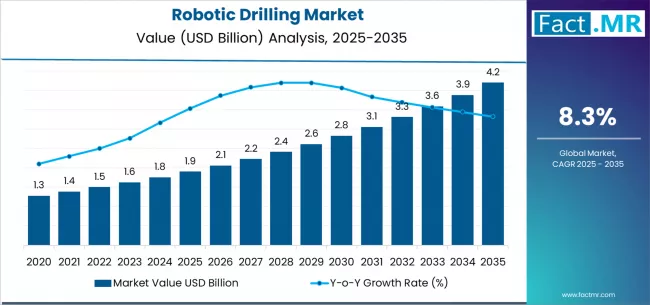
Between 2025 and 2030, the robotic drilling market is projected to expand from USD 1,900.0 million to USD 2,850.0 million, resulting in a value increase of USD 950.0 million, which represents 41.3% of the total forecast growth for the decade. This phase of development will be shaped by rising demand for automated drilling technologies, increasing applications in energy extraction optimization, and growing penetration in emerging drilling markets. Energy companies are expanding their robotic drilling capabilities to address the growing demand for advanced drilling systems in various oil & gas applications and mining operations.
Robotic Drilling Market Key Takeaways
| Metric | Value |
|---|---|
| Estimated Value in (2025E) | USD 1,900.0 million |
| Forecast Value in (2035F) | USD 4,200.0 million |
| Forecast CAGR (2025 to 2035) | 8.3% |
From 2030 to 2035, the market is forecast to grow from USD 2,850.0 million to USD 4,200.0 million, adding another USD 1,350.0 million, which constitutes 58.7% of the overall ten-year expansion. This period is expected to be characterized by the expansion of advanced drilling facilities, the integration of cutting-edge automation technologies, and the development of customized drilling systems for specific energy applications. The growing adoption of premium drilling standards and energy requirements will drive demand for ultra-high efficiency robotic drilling systems with enhanced performance specifications and consistent operational characteristics.
Between 2020 and 2025, the robotic drilling market experienced steady expansion, driven by increasing recognition of automated drilling technologies' importance in energy operations and growing acceptance of advanced drilling solutions in complex extraction applications. The market developed as energy companies recognized the need for high-efficiency drilling systems to address extraction requirements and improve overall operational outcomes. Research and development activities have begun to emphasize the importance of advanced robotic drilling technologies in achieving better efficiency and quality in drilling processes.
Why is the Robotic Drilling Market Growing?
Market expansion is being supported by the increasing demand for automated drilling solutions and the corresponding need for high-efficiency drilling systems in robotic drilling applications across global energy and mining operations.
Modern energy producers are increasingly focused on advanced robotic drilling technologies that can improve operational efficiency, reduce drilling costs, and enhance safety performance while meeting stringent regulatory requirements. The proven efficacy of robotic drilling systems in various energy applications makes them an essential component of comprehensive drilling strategies and energy extraction programs.
The growing emphasis on energy industry transformation and advanced drilling optimization is driving demand for ultra-efficient robotic drilling systems that meet stringent performance specifications and safety requirements for energy applications.
Energy companies' preference for reliable, high-performance drilling systems that can ensure consistent operational outcomes is creating opportunities for innovative robotic drilling technologies and customized automation solutions.
The rising influence of drilling safety guidelines and energy protocols is also contributing to increased adoption of premium-grade robotic drilling systems across different energy applications and drilling systems requiring advanced automation technology.
Opportunity Pathways - Robotic Drilling Market
The robotic drilling market represents a specialized growth opportunity, expanding from USD 1,900.0 million in 2025 to USD 4,200.0 million by 2035 at a 8.3% CAGR. As energy companies prioritize operational efficiency, safety compliance, and drilling performance in complex energy operations, robotic drilling systems have evolved from a niche drilling technology to an essential component enabling extraction delivery, operational optimization, and multi-stage drilling production across energy operations and specialized mining applications.
The convergence of energy industry expansion, increasing automation adoption, specialized drilling organization growth, and operational requirements creates momentum in demand. High-efficiency formulations offering superior drilling performance, cost-effective rig automation variants balancing performance with economics, and specialized robotic drill rig variants for critical applications will capture market premiums, while geographic expansion into high-growth Asian energy markets and emerging market penetration will drive volume leadership. Energy industry emphasis on drilling quality and operational reliability provides structural support.
- Pathway A - Oil & Gas Sector Dominance: Leading with 65.0% market share, oil & gas applications drive primary demand through complex energy workflows requiring comprehensive drilling systems for extraction development. Advanced formulations enabling improved drilling performance, reduced operational complexity, and enhanced safety outcomes command premium pricing from energy companies requiring stringent performance specifications and regulatory compliance. Expected revenue pool: USD 1,235.0-2,730.0 million.
- Pathway B - Rig Automation System Leadership: Dominating with 55.0% market share through an optimal balance of performance and cost-effectiveness, rig automation serves most energy operations while meeting drilling requirements. This system addresses both performance standards and economic considerations, making it the preferred choice for energy and drilling operations seeking reliable automation performance. Opportunity: USD 1,045.0-2,310.0 million.
- Pathway C - Asian Market Acceleration: India (10.2% CAGR) and China (9.2% CAGR) lead global growth through energy infrastructure expansion, drilling capability development, and domestic robotic drilling demand. Strategic partnerships with local energy producers, regulatory compliance expertise, and supply chain localization enable the expansion of drilling automation technology in major energy hubs. Geographic expansion upside: USD 450.0-850.0 million.
- Pathway D - Onshore Deployment Premium Segment: Onshore deployment serves specialized applications requiring exceptional performance specifications for critical drilling processes. Onshore formulations supporting land-based drilling requirements, complex energy applications, and performance-sensitive processes command significant premiums from advanced energy organizations and specialized drilling facilities. Revenue potential: USD 1,140.0-2,520.0 million.
- Pathway E - Advanced Drilling & Technology Systems: Companies investing in sophisticated robotic drilling technologies, automation systems, and automated drilling processes gain competitive advantages through consistent system performance and drilling quality reliability. Advanced capabilities enabling customized specifications and rapid deployment capture premium energy partnerships. Technology premium: USD 320.0-680.0 million.
- Pathway F - Supply Chain Optimization & Reliability: Specialized distribution networks, strategic inventory management, and reliable supply chain systems create competitive differentiation in energy markets requiring consistent robotic drilling availability. Companies offering guaranteed supply security, technical support, and drilling documentation gain preferred supplier status with compliance-focused energy companies. Supply chain value: USD 250.0-520.0 million.
- Pathway G - Emerging Applications & Market Development: Beyond traditional oil & gas applications, robotic drilling in mining, construction, and specialized extraction systems represent growth opportunities. Companies developing new applications, supporting R&D initiatives, and expanding into adjacent energy markets capture incremental demand while diversifying revenue streams. Emerging opportunity: USD 180.0-420.0 million.
Segmental Analysis
The market is segmented by sector, system type, deployment type, and region. By sector, the market is divided into oil & gas, mining, and construction. Based on system type, the market is categorized into rig automation, robotic drill rigs, and retrofit/controls. By deployment type, the market is divided into offshore and onshore. Regionally, the market is divided into Asia Pacific, North America, Europe, Latin America, Middle East & Africa.
By Sector, Oil & Gas Segment Accounts for 65.0% Market Share
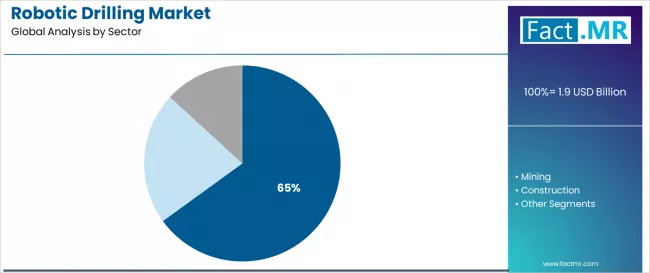
The oil & gas segment is projected to account for 65.0% of the robotic drilling market in 2025, reaffirming its position as the category's dominant sector. Energy companies increasingly recognize the optimal balance of performance and cost-effectiveness offered by robotic drilling for most oil & gas applications, particularly in extraction operations and energy production. This sector addresses both performance requirements and economic considerations while providing reliable drilling capabilities across diverse energy applications.
This sector forms the foundation of most energy protocols for drilling applications, as it represents the most widely accepted and commercially viable level of robotic drilling technology in the industry. Performance control standards and extensive energy testing continue to strengthen confidence in oil & gas formulations among energy and drilling operators. With increasing recognition of the cost-performance optimization requirements in energy operations, oil & gas systems align with both operational efficiency and extraction goals, making them the central growth driver of comprehensive drilling strategies.
By System Type, Rig Automation Segment Accounts for 55.0% Market Share
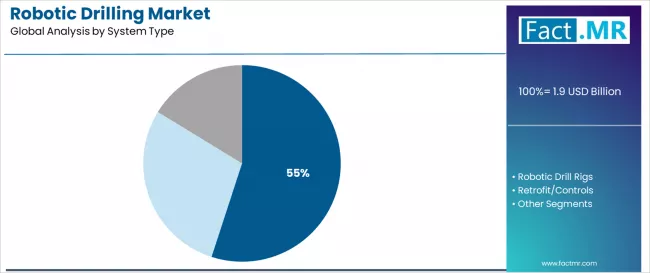
Rig automation systems are projected to represent 55.0% of robotic drilling demand in 2025, underscoring their role as the primary system segment driving market adoption and growth. Energy companies recognize that automation requirements, including complex drilling processes, specialized control needs, and multi-stage drilling systems, often require advanced rig automation systems that standard drilling technologies cannot adequately provide. Rig automation offers enhanced operational performance and safety compliance in energy applications.
The segment is supported by the growing nature of automation adoption, requiring sophisticated drilling systems, and the increasing recognition that advanced rig automation technologies can improve energy performance and operational outcomes. Additionally, energy companies are increasingly adopting evidence-based drilling guidelines that recommend specific rig automation systems for optimal operational outcomes. As understanding of drilling complexity advances and energy requirements become more stringent, rig automation will continue to play a crucial role in comprehensive drilling strategies within the energy market.
What are the Drivers, Restraints, and Key Trends of the Robotic Drilling Market?
The robotic drilling market is advancing steadily due to increasing recognition of automated drilling technologies' importance and growing demand for high-efficiency drilling systems across the energy and mining sectors.
However, the market faces challenges, including complex technical integration processes, potential for system variations during operation and maintenance, and concerns about supply chain consistency for specialized drilling equipment. Innovation in robotic drilling technologies and customized energy protocols continues to influence product development and market expansion patterns.
Expansion of Advanced Energy Facilities and Robotic Drilling Technologies
The growing adoption of advanced energy facilities is enabling the development of more sophisticated robotic drilling production and performance control systems that can meet stringent energy safety requirements.
Specialized energy facilities offer comprehensive robotic drilling services, including advanced drilling and automation processes that are particularly important for achieving high-efficiency requirements in energy applications.
Advanced drilling channels provide access to premium systems that can optimize energy performance and reduce drilling costs while maintaining cost-effectiveness for large-scale energy operations.
Integration of Digital Energy Systems and Drilling Management Systems
Modern energy organizations are incorporating digital technologies such as real-time performance monitoring, automated drilling systems, and supply chain integration to enhance robotic drilling operation and maintenance processes.
These technologies improve drilling performance, enable continuous safety monitoring, and provide better coordination between suppliers and operators throughout the energy cycle. Advanced digital platforms also enable customized performance specifications and early identification of potential system deviations or supply disruptions, supporting reliable energy drilling production.
Analysis of the Robotic Drilling Market by Key Country
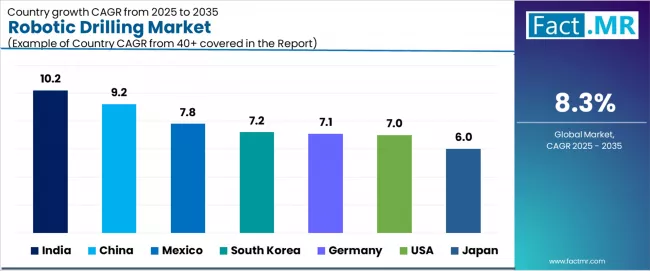
| Country | CAGR (2025-2035) |
|---|---|
| India | 10.2% |
| China | 9.2% |
| Mexico | 7.8% |
| South Korea | 7.2% |
| Germany | 7.1% |
| USA | 7.0% |
| Japan | 6.0% |
The robotic drilling market is experiencing varied growth globally, with India leading at a 10.2% CAGR through 2035, driven by the expansion of energy infrastructure development, increasing drilling capabilities, and growing domestic demand for high-efficiency robotic drilling systems.
China follows at 9.2%, supported by energy industry expansion, growing recognition of advanced drilling technology importance, and expanding energy capacity. Mexico records 7.8% growth, with focus on developing energy and mining industries. South Korea shows 7.2% growth, driven by advanced drilling technology adoption.
Germany demonstrates 7.1% growth, emphasizing energy infrastructure expansion and systematic drilling approaches. USA maintains 7.0% growth, driven by energy technology advancement. Japan demonstrates 6.0% growth, emphasizing precision drilling management and energy optimization.
India Demonstrates Growing Market Potential with Energy Infrastructure Development
Revenue from robotic drilling in India is projected to exhibit robust growth with a CAGR of 10.2% through 2035, driven by ongoing energy industry expansion and increasing recognition of high-efficiency robotic drilling systems as essential drilling components for complex energy processes. The country's expanding energy infrastructure and growing availability of specialized drilling capabilities are creating significant opportunities for robotic drilling adoption across both domestic and export-oriented energy facilities. Major international and domestic energy companies are establishing comprehensive drilling and distribution networks to serve the growing population of energy providers and drilling facilities requiring high-performance robotic drilling systems across oil & gas and mining applications throughout India's major energy hubs.
The Indian government's strategic emphasis on energy modernization and drilling advancement is driving substantial investments in specialized drilling capabilities. This policy support, combined with the country's large domestic energy market and expanding drilling requirements, creates a favorable environment for the robotic drilling market development. Indian energy companies are increasingly focusing on high-value drilling technologies to improve energy capabilities, with robotic drilling representing a key component in this energy industry transformation.
- Government initiatives supporting energy development and drilling modernization are driving demand for high-efficiency robotic drilling systems throughout major energy and drilling centers, including Mumbai, Chennai, and Ahmedabad regions.
- Energy capacity expansion and drilling system development are supporting appropriate utilization of robotic drilling among energy companies and drilling facilities nationwide, with particular growth in oil & gas operations and mining services.
China Demonstrates Exceptional Market Potential with Energy Industry Growth
Revenue from robotic drilling in China is expanding at a CAGR of 9.2%, supported by increasing energy accessibility, growing drilling awareness, and developing automation technology market presence across the country's major energy clusters. The country's large energy sector and increasing recognition of advanced robotic drilling systems are driving demand for effective high-efficiency drilling solutions in both energy and mining applications. International energy companies and domestic providers are establishing comprehensive distribution channels to serve the growing demand for quality robotic drilling systems while supporting the country's position as an emerging drilling automation market.
China's energy sector continues to benefit from favorable drilling policies, expanding energy capabilities, and cost-competitive energy infrastructure development. The country's focus on becoming a global energy technology hub is driving investments in specialized robotic drilling technology and energy infrastructure. This development is particularly important for robotic drilling applications, as energy companies seek reliable domestic sources for critical drilling equipment to reduce import dependency and improve supply chain security.
- Rising awareness about advanced drilling options and improving energy capabilities are creating opportunities for specialized robotic drilling systems across energy and mining settings in major hubs like Beijing, Shanghai, and Xi'an.
- Growing energy infrastructure development and technology adoption are supporting increased access to high-efficiency robotic drilling among organizations requiring comprehensive drilling capabilities, particularly in energy and mining organizations.
Mexico Shows Strong Regional Development
Mexico's robotic drilling market demonstrates solid growth potential with a 7.8% CAGR through 2035, driven by expanding energy capabilities, growing mining industry development, and increasing recognition of premium drilling technologies in energy operations. The country's strategic position as a regional energy hub and growing domestic demand for high-quality drilling systems are creating substantial opportunities for robotic drilling adoption across both traditional and modern energy facilities. International energy companies and local mining providers are establishing comprehensive drilling equipment supply networks to serve Mexico's expanding energy industry requirements.
The Mexican energy sector benefits from favorable trade relationships, expanding energy infrastructure, and growing industry awareness of quality drilling equipment. Government initiatives supporting energy industry modernization and mining development are driving investments in advanced drilling technologies. Mexican energy companies are increasingly adopting international drilling standards and energy technologies, with robotic drilling representing an important component in achieving premium energy specifications and meeting drilling market requirements.
- Energy industry expansion programs and mining development initiatives are creating demand for specialized robotic drilling systems across major energy regions, including Mexico City, Guadalajara, and Veracruz areas.
- Growing oil & gas and mining sectors are driving increased utilization of robotic drilling equipment among energy companies seeking to improve drilling outcomes and energy efficiency in both domestic and export-oriented operations.
South Korea Demonstrates Premium Market Development
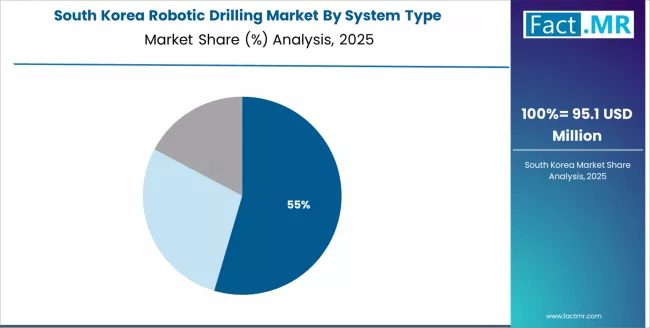
South Korea's robotic drilling market exhibits steady growth with a 7.2% CAGR through 2035, characterized by advanced energy capabilities, premium drilling adoption, and sophisticated energy standards across the country's concentrated energy industry clusters. The market benefits from high energy quality expectations, advanced drilling technology infrastructure, and strong government support for energy industry innovation. Korean energy companies are increasingly incorporating international drilling standards and advanced energy technologies to meet both domestic premium market demands and energy requirements.
The country's focus on energy safety, quality control, and technological advancement creates favorable conditions for premium robotic drilling adoption across specialized energy applications. South Korean energy companies prioritize equipment traceability, quality consistency, and drilling efficiency, driving demand for high-specification robotic drilling systems that meet stringent energy requirements. The market also benefits from strong research and development capabilities and close integration with global energy technology trends.
- Advanced energy facilities in Seoul, Busan, and Incheon regions are driving demand for premium robotic drilling systems that meet sophisticated quality control and drilling efficiency requirements.
- Growing oil & gas and mining sectors, combined with expanding energy equipment distribution, are supporting increased adoption of specialized robotic drilling systems among energy companies focused on premium energy development and drilling market penetration.
Germany Shows Strong Regional Leadership
Germany's market expansion benefits from diverse energy demand, including drilling modernization in Berlin and Munich, energy development programs, and government energy programs that increasingly incorporate robotic drilling solutions for energy enhancement applications. The country maintains a 7.1% CAGR through 2035, driven by rising energy awareness and increasing adoption of drilling benefits, including superior energy capabilities and reduced drilling complexity.
Market dynamics focus on cost-effective robotic drilling solutions that balance advanced energy features with affordability considerations important to German energy operators. Growing energy infrastructure creates demand for modern drilling systems in new energy facilities and drilling equipment modernization projects.
Strategic Market Considerations:
- Energy and drilling segments leading growth with focus on energy enhancement and operational efficiency applications
- Regional energy requirements are driving a diverse product portfolio from basic robotic drilling systems to advanced drilling platforms
- Import dependency challenges offset by potential local development partnerships with international drilling manufacturers
- Government energy initiatives beginning to influence procurement standards and drilling requirements
USA Maintains Technology Leadership
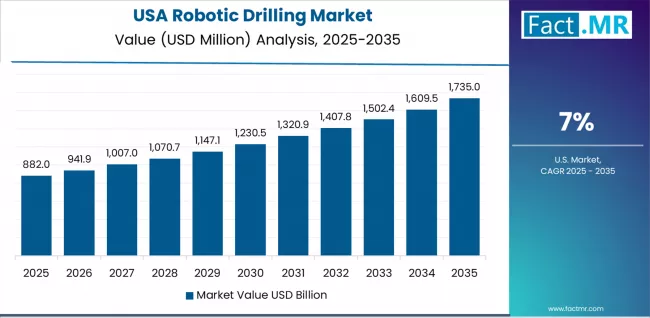
USA's advanced energy technology market demonstrates sophisticated drilling deployment with documented robotic drilling effectiveness in energy departments and drilling centers through integration with existing energy systems and drilling infrastructure. The country leverages energy expertise in drilling technology and energy systems integration to maintain a 7.0% CAGR through 2035. Energy centers, including major metropolitan areas, showcase premium installations where robotic drilling systems integrate with comprehensive energy information systems and drilling platforms to optimize energy accuracy and operational workflow effectiveness.
American energy companies prioritize system reliability and regulatory compliance in drilling development, creating demand for premium systems with advanced features, including performance validation and integration with US energy standards. The market benefits from established energy industry infrastructure and a willingness to invest in advanced robotic drilling technologies that provide long-term operational benefits and compliance with energy regulations.
Japan Emphasizes Precision and Integration Excellence
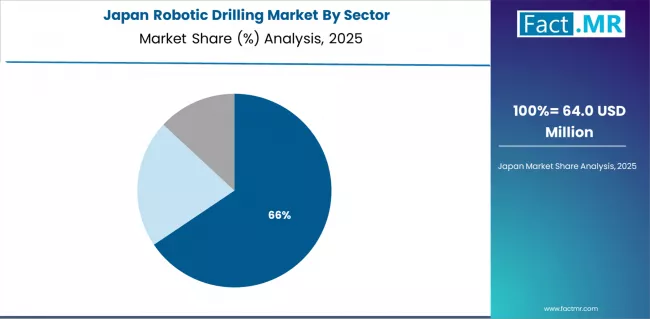
Japan demonstrates steady market development with a 6.0% CAGR through 2035, distinguished by energy operators' preference for high-quality robotic drilling systems that integrate seamlessly with existing energy equipment and provide reliable long-term operation in specialized drilling applications. The market prioritizes advanced features, including precision drilling algorithms, quality validation, and integration with comprehensive energy platforms that reflect Japanese energy expectations for technological sophistication and operational excellence.
Japanese energy companies focus on system reliability and precision in robotic drilling development, creating demand for premium systems with advanced features including automated quality monitoring and comprehensive drilling support. The market benefits from established energy research infrastructure and investment in drilling technology that provides long-term energy benefits.
Strategic Market Indicators:
- Premium focus on precision systems with advanced drilling algorithms and high-reliability capabilities
- Integration requirements with existing energy information systems and drilling management platforms
- Emphasis on robotic drilling reliability and long-term performance in energy applications
Europe Market Split by Country
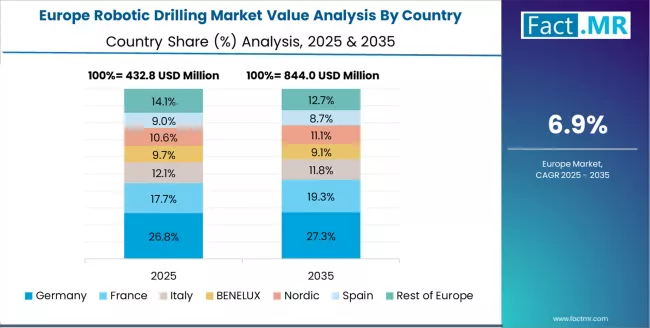
The robotic drilling market in Europe is projected to grow from USD 1,890.0 million in 2025 to USD 4,180.0 million by 2035, registering a CAGR of 8.3% over the forecast period. Germany is expected to maintain its leadership position with a 24.3% market share in 2025, rising to 24.6% by 2035, supported by its advanced energy infrastructure, precision drilling capabilities, and strong energy industry presence throughout major drilling regions.
The United Kingdom follows with a 17.5% share in 2025, projected to reach 17.7% by 2035, driven by advanced energy protocols, drilling innovation integration, and expanding specialty energy networks serving both domestic and international markets. France holds a 14.3% share in 2025, expected to increase to 14.5% by 2035, supported by energy infrastructure expansion and growing adoption of high-efficiency robotic drilling systems.
Italy commands a 11.1% share in 2025, projected to reach 11.3% by 2035, while Spain accounts for 9.0% in 2025, expected to reach 9.2% by 2035. The Rest of Europe region, including Nordic countries, Eastern Europe, and smaller Western European markets, is anticipated to hold 24.3% in 2025, declining slightly to 22.7% by 2035, attributed to market consolidation toward larger core markets with established energy and drilling capabilities.
Competitive Landscape of the Robotic Drilling Market
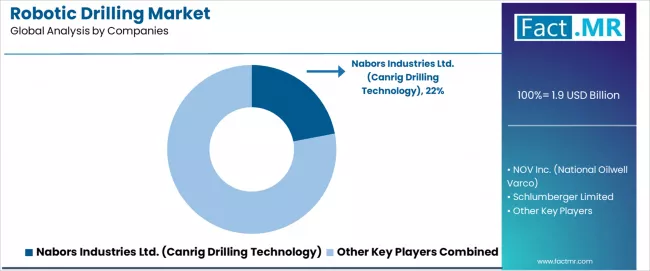
The robotic drilling market is characterized by competition among established energy equipment manufacturers, specialty drilling companies, and automation technology suppliers focused on delivering high-efficiency, consistent, and reliable robotic drilling systems.
Companies are investing in drilling technology advancement, performance control enhancement, strategic partnerships, and customer technical support to deliver effective, efficient, and reliable robotic drilling solutions that meet stringent energy and safety requirements. Drilling optimization, performance validation protocols, and supply chain strategies are central to strengthening product portfolios and market presence.
Nabors/Canrig leads the market with comprehensive high-efficiency robotic drilling system offerings with a focus on performance consistency and operational reliability for energy applications. NOV provides specialized drilling systems with emphasis on energy applications and comprehensive technical support services.
Schlumberger focuses on advanced robotic drilling technologies and customized energy solutions for drilling systems serving global markets. Halliburton delivers established energy systems with strong performance control systems and customer service capabilities.
Epiroc operates with a focus on bringing innovative robotic drilling technologies to specialized mining applications and emerging markets. Sandvik provides comprehensive drilling system portfolios, including advanced robotic drilling, across multiple energy applications and mining processes. Huisman specializes in customized drilling solutions and quality management systems for energy systems with emphasis on regulatory compliance. Robit provides reliable supply chain solutions and technical expertise to enhance market accessibility and customer access to essential robotic drilling systems.
Key Players in the Robotic Drilling Market
- Nabors Industries Ltd. (Canrig Drilling Technology)
- NOV Inc. (National Oilwell Varco)
- Schlumberger Limited
- Halliburton Company
- Epiroc AB
- Sandvik AB
- Huisman Equipment B.V.
- Robit Plc
- Herrenknecht AG
- Caterpillar Inc.
- Komatsu Ltd.
- Boart Longyear Limited
- Atlas Copco AB (legacy operations)
- Drillmec S.p.A.
- Cyberbase Ltd.
Scope of the Report
| Items | Values |
|---|---|
| Quantitative Units (2025) | USD 1,900.0 Million |
| Sector | Oil & Gas, Mining, Construction |
| System Type | Rig Automation, Robotic Drill Rigs, Retrofit/Controls |
| Deployment Type | Offshore, Onshore |
| Regions Covered | Asia Pacific, North America, Europe, Latin America, Middle East & Africa |
| Countries Covered | China, USA, Germany, Japan, India, South Korea, Mexico and 40+ countries |
| Key Companies Profiled | Nabors/Canrig, NOV, Schlumberger, Halliburton, Epiroc, Sandvik, Huisman, and Robit |
| Additional Attributes | Dollar sales by sector and system type, regional demand trends, competitive landscape, energy company preferences for specific robotic drilling systems, integration with specialty energy supply chains, innovations in drilling technologies, performance monitoring, and operational optimization |
Robotic Drilling Market by Segments
-
Sector :
- Oil & Gas
- Mining
- Construction
-
System Type :
- Rig Automation
- Robotic Drill Rigs
- Retrofit/Controls
-
Deployment Type :
- Offshore
- Onshore
-
Region :
-
Asia Pacific
- China
- India
- Japan
- South Korea
- ASEAN
- Australia & New Zealand
- Rest of Asia Pacific
-
North America
- United States
- Canada
- Mexico
-
Europe
- Germany
- United Kingdom
- France
- Italy
- Spain
- Nordic
- BENELUX
- Rest of Europe
-
Latin America
- Brazil
- Argentina
- Chile
- Rest of Latin America
-
Middle East & Africa
- Kingdom of Saudi Arabia
- Other GCC Countries
- Turkey
- South Africa
- Other African Countries
- Rest of Middle East & Africa
-
Table of Content
- Executive Summary
- Global Market Outlook
- Demand to side Trends
- Supply to side Trends
- Technology Roadmap Analysis
- Analysis and Recommendations
- Market Overview
- Market Coverage / Taxonomy
- Market Definition / Scope / Limitations
- Market Background
- Market Dynamics
- Drivers
- Restraints
- Opportunity
- Trends
- Scenario Forecast
- Demand in Optimistic Scenario
- Demand in Likely Scenario
- Demand in Conservative Scenario
- Opportunity Map Analysis
- Product Life Cycle Analysis
- Supply Chain Analysis
- Investment Feasibility Matrix
- Value Chain Analysis
- PESTLE and Porter’s Analysis
- Regulatory Landscape
- Regional Parent Market Outlook
- Production and Consumption Statistics
- Import and Export Statistics
- Market Dynamics
- Global Market Analysis 2020 to 2024 and Forecast, 2025 to 2035
- Historical Market Size Value (USD Million) Analysis, 2020 to 2024
- Current and Future Market Size Value (USD Million) Projections, 2025 to 2035
- Y to o to Y Growth Trend Analysis
- Absolute $ Opportunity Analysis
- Global Market Pricing Analysis 2020 to 2024 and Forecast 2025 to 2035
- Global Market Analysis 2020 to 2024 and Forecast 2025 to 2035, By Sector
- Introduction / Key Findings
- Historical Market Size Value (USD Million) Analysis By Sector , 2020 to 2024
- Current and Future Market Size Value (USD Million) Analysis and Forecast By Sector , 2025 to 2035
- Oil & Gas
- Mining
- Construction
- Y to o to Y Growth Trend Analysis By Sector , 2020 to 2024
- Absolute $ Opportunity Analysis By Sector , 2025 to 2035
- Global Market Analysis 2020 to 2024 and Forecast 2025 to 2035, By System Type
- Introduction / Key Findings
- Historical Market Size Value (USD Million) Analysis By System Type, 2020 to 2024
- Current and Future Market Size Value (USD Million) Analysis and Forecast By System Type, 2025 to 2035
- Rig Automation
- Robotic Drill Rigs
- Retrofit/Controls
- Y to o to Y Growth Trend Analysis By System Type, 2020 to 2024
- Absolute $ Opportunity Analysis By System Type, 2025 to 2035
- Global Market Analysis 2020 to 2024 and Forecast 2025 to 2035, By Region
- Introduction
- Historical Market Size Value (USD Million) Analysis By Region, 2020 to 2024
- Current Market Size Value (USD Million) Analysis and Forecast By Region, 2025 to 2035
- North America
- Latin America
- Western Europe
- Eastern Europe
- East Asia
- South Asia and Pacific
- Middle East & Africa
- Market Attractiveness Analysis By Region
- North America Market Analysis 2020 to 2024 and Forecast 2025 to 2035, By Country
- Historical Market Size Value (USD Million) Trend Analysis By Market Taxonomy, 2020 to 2024
- Market Size Value (USD Million) Forecast By Market Taxonomy, 2025 to 2035
- By Country
- USA
- Canada
- Mexico
- By Sector
- By System Type
- By Country
- Market Attractiveness Analysis
- By Country
- By Sector
- By System Type
- Key Takeaways
- Latin America Market Analysis 2020 to 2024 and Forecast 2025 to 2035, By Country
- Historical Market Size Value (USD Million) Trend Analysis By Market Taxonomy, 2020 to 2024
- Market Size Value (USD Million) Forecast By Market Taxonomy, 2025 to 2035
- By Country
- Brazil
- Chile
- Rest of Latin America
- By Sector
- By System Type
- By Country
- Market Attractiveness Analysis
- By Country
- By Sector
- By System Type
- Key Takeaways
- Western Europe Market Analysis 2020 to 2024 and Forecast 2025 to 2035, By Country
- Historical Market Size Value (USD Million) Trend Analysis By Market Taxonomy, 2020 to 2024
- Market Size Value (USD Million) Forecast By Market Taxonomy, 2025 to 2035
- By Country
- Germany
- UK
- Italy
- Spain
- France
- Nordic
- BENELUX
- Rest of Western Europe
- By Sector
- By System Type
- By Country
- Market Attractiveness Analysis
- By Country
- By Sector
- By System Type
- Key Takeaways
- Eastern Europe Market Analysis 2020 to 2024 and Forecast 2025 to 2035, By Country
- Historical Market Size Value (USD Million) Trend Analysis By Market Taxonomy, 2020 to 2024
- Market Size Value (USD Million) Forecast By Market Taxonomy, 2025 to 2035
- By Country
- Russia
- Poland
- Hungary
- Balkan & Baltic
- Rest of Eastern Europe
- By Sector
- By System Type
- By Country
- Market Attractiveness Analysis
- By Country
- By Sector
- By System Type
- Key Takeaways
- East Asia Market Analysis 2020 to 2024 and Forecast 2025 to 2035, By Country
- Historical Market Size Value (USD Million) Trend Analysis By Market Taxonomy, 2020 to 2024
- Market Size Value (USD Million) Forecast By Market Taxonomy, 2025 to 2035
- By Country
- China
- Japan
- South Korea
- By Sector
- By System Type
- By Country
- Market Attractiveness Analysis
- By Country
- By Sector
- By System Type
- Key Takeaways
- South Asia and Pacific Market Analysis 2020 to 2024 and Forecast 2025 to 2035, By Country
- Historical Market Size Value (USD Million) Trend Analysis By Market Taxonomy, 2020 to 2024
- Market Size Value (USD Million) Forecast By Market Taxonomy, 2025 to 2035
- By Country
- India
- ASEAN
- Australia & New Zealand
- Rest of South Asia and Pacific
- By Sector
- By System Type
- By Country
- Market Attractiveness Analysis
- By Country
- By Sector
- By System Type
- Key Takeaways
- Middle East & Africa Market Analysis 2020 to 2024 and Forecast 2025 to 2035, By Country
- Historical Market Size Value (USD Million) Trend Analysis By Market Taxonomy, 2020 to 2024
- Market Size Value (USD Million) Forecast By Market Taxonomy, 2025 to 2035
- By Country
- Kingdom of Saudi Arabia
- Other GCC Countries
- Turkiye
- South Africa
- Other African Union
- Rest of Middle East & Africa
- By Sector
- By System Type
- By Country
- Market Attractiveness Analysis
- By Country
- By Sector
- By System Type
- Key Takeaways
- Key Countries Market Analysis
- USA
- Pricing Analysis
- Market Share Analysis, 2024
- By Sector
- By System Type
- Canada
- Pricing Analysis
- Market Share Analysis, 2024
- By Sector
- By System Type
- Mexico
- Pricing Analysis
- Market Share Analysis, 2024
- By Sector
- By System Type
- Brazil
- Pricing Analysis
- Market Share Analysis, 2024
- By Sector
- By System Type
- Chile
- Pricing Analysis
- Market Share Analysis, 2024
- By Sector
- By System Type
- Germany
- Pricing Analysis
- Market Share Analysis, 2024
- By Sector
- By System Type
- UK
- Pricing Analysis
- Market Share Analysis, 2024
- By Sector
- By System Type
- Italy
- Pricing Analysis
- Market Share Analysis, 2024
- By Sector
- By System Type
- Spain
- Pricing Analysis
- Market Share Analysis, 2024
- By Sector
- By System Type
- France
- Pricing Analysis
- Market Share Analysis, 2024
- By Sector
- By System Type
- India
- Pricing Analysis
- Market Share Analysis, 2024
- By Sector
- By System Type
- ASEAN
- Pricing Analysis
- Market Share Analysis, 2024
- By Sector
- By System Type
- Australia & New Zealand
- Pricing Analysis
- Market Share Analysis, 2024
- By Sector
- By System Type
- China
- Pricing Analysis
- Market Share Analysis, 2024
- By Sector
- By System Type
- Japan
- Pricing Analysis
- Market Share Analysis, 2024
- By Sector
- By System Type
- South Korea
- Pricing Analysis
- Market Share Analysis, 2024
- By Sector
- By System Type
- Russia
- Pricing Analysis
- Market Share Analysis, 2024
- By Sector
- By System Type
- Poland
- Pricing Analysis
- Market Share Analysis, 2024
- By Sector
- By System Type
- Hungary
- Pricing Analysis
- Market Share Analysis, 2024
- By Sector
- By System Type
- Kingdom of Saudi Arabia
- Pricing Analysis
- Market Share Analysis, 2024
- By Sector
- By System Type
- Turkiye
- Pricing Analysis
- Market Share Analysis, 2024
- By Sector
- By System Type
- South Africa
- Pricing Analysis
- Market Share Analysis, 2024
- By Sector
- By System Type
- USA
- Market Structure Analysis
- Competition Dashboard
- Competition Benchmarking
- Market Share Analysis of Top Players
- By Regional
- By Sector
- By System Type
- Competition Analysis
- Competition Deep Dive
- Nabors Industries Ltd. (Canrig Drilling Technology)
- Overview
- Product Portfolio
- Profitability by Market Segments (Product/Age /Sales Channel/Region)
- Sales Footprint
- Strategy Overview
- Marketing Strategy
- Product Strategy
- Channel Strategy
- NOV Inc. (National Oilwell Varco)
- Schlumberger Limited
- Halliburton Company
- Epiroc AB
- Sandvik AB
- Huisman Equipment B.V.
- Robit Plc
- Herrenknecht AG
- Caterpillar Inc.
- Komatsu Ltd.
- Boart Longyear Limited
- Atlas Copco AB (legacy operations)
- Drillmec S.p.A.
- Cyberbase Ltd.
- Nabors Industries Ltd. (Canrig Drilling Technology)
- Competition Deep Dive
- Assumptions & Acronyms Used
- Research Methodology
List Of Table
- Table 1: Global Market Value (USD Million) Forecast by Region, 2020 to 2035
- Table 2: Global Market Value (USD Million) Forecast by Sector , 2020 to 2035
- Table 3: Global Market Value (USD Million) Forecast by System Type, 2020 to 2035
- Table 4: North America Market Value (USD Million) Forecast by Country, 2020 to 2035
- Table 5: North America Market Value (USD Million) Forecast by Sector , 2020 to 2035
- Table 6: North America Market Value (USD Million) Forecast by System Type, 2020 to 2035
- Table 7: Latin America Market Value (USD Million) Forecast by Country, 2020 to 2035
- Table 8: Latin America Market Value (USD Million) Forecast by Sector , 2020 to 2035
- Table 9: Latin America Market Value (USD Million) Forecast by System Type, 2020 to 2035
- Table 10: Western Europe Market Value (USD Million) Forecast by Country, 2020 to 2035
- Table 11: Western Europe Market Value (USD Million) Forecast by Sector , 2020 to 2035
- Table 12: Western Europe Market Value (USD Million) Forecast by System Type, 2020 to 2035
- Table 13: Eastern Europe Market Value (USD Million) Forecast by Country, 2020 to 2035
- Table 14: Eastern Europe Market Value (USD Million) Forecast by Sector , 2020 to 2035
- Table 15: Eastern Europe Market Value (USD Million) Forecast by System Type, 2020 to 2035
- Table 16: East Asia Market Value (USD Million) Forecast by Country, 2020 to 2035
- Table 17: East Asia Market Value (USD Million) Forecast by Sector , 2020 to 2035
- Table 18: East Asia Market Value (USD Million) Forecast by System Type, 2020 to 2035
- Table 19: South Asia and Pacific Market Value (USD Million) Forecast by Country, 2020 to 2035
- Table 20: South Asia and Pacific Market Value (USD Million) Forecast by Sector , 2020 to 2035
- Table 21: South Asia and Pacific Market Value (USD Million) Forecast by System Type, 2020 to 2035
- Table 22: Middle East & Africa Market Value (USD Million) Forecast by Country, 2020 to 2035
- Table 23: Middle East & Africa Market Value (USD Million) Forecast by Sector , 2020 to 2035
- Table 24: Middle East & Africa Market Value (USD Million) Forecast by System Type, 2020 to 2035
List Of Figures
- Figure 1: Global Market Pricing Analysis
- Figure 2: Global Market Value (USD Million) Forecast 2020-2035
- Figure 3: Global Market Value Share and BPS Analysis by Sector , 2025 and 2035
- Figure 4: Global Market Y to o to Y Growth Comparison by Sector , 2025-2035
- Figure 5: Global Market Attractiveness Analysis by Sector
- Figure 6: Global Market Value Share and BPS Analysis by System Type, 2025 and 2035
- Figure 7: Global Market Y to o to Y Growth Comparison by System Type, 2025-2035
- Figure 8: Global Market Attractiveness Analysis by System Type
- Figure 9: Global Market Value (USD Million) Share and BPS Analysis by Region, 2025 and 2035
- Figure 10: Global Market Y to o to Y Growth Comparison by Region, 2025-2035
- Figure 11: Global Market Attractiveness Analysis by Region
- Figure 12: North America Market Incremental Dollar Opportunity, 2025-2035
- Figure 13: Latin America Market Incremental Dollar Opportunity, 2025-2035
- Figure 14: Western Europe Market Incremental Dollar Opportunity, 2025-2035
- Figure 15: Eastern Europe Market Incremental Dollar Opportunity, 2025-2035
- Figure 16: East Asia Market Incremental Dollar Opportunity, 2025-2035
- Figure 17: South Asia and Pacific Market Incremental Dollar Opportunity, 2025-2035
- Figure 18: Middle East & Africa Market Incremental Dollar Opportunity, 2025-2035
- Figure 19: North America Market Value Share and BPS Analysis by Country, 2025 and 2035
- Figure 20: North America Market Value Share and BPS Analysis by Sector , 2025 and 2035
- Figure 21: North America Market Y to o to Y Growth Comparison by Sector , 2025-2035
- Figure 22: North America Market Attractiveness Analysis by Sector
- Figure 23: North America Market Value Share and BPS Analysis by System Type, 2025 and 2035
- Figure 24: North America Market Y to o to Y Growth Comparison by System Type, 2025-2035
- Figure 25: North America Market Attractiveness Analysis by System Type
- Figure 26: Latin America Market Value Share and BPS Analysis by Country, 2025 and 2035
- Figure 27: Latin America Market Value Share and BPS Analysis by Sector , 2025 and 2035
- Figure 28: Latin America Market Y to o to Y Growth Comparison by Sector , 2025-2035
- Figure 29: Latin America Market Attractiveness Analysis by Sector
- Figure 30: Latin America Market Value Share and BPS Analysis by System Type, 2025 and 2035
- Figure 31: Latin America Market Y to o to Y Growth Comparison by System Type, 2025-2035
- Figure 32: Latin America Market Attractiveness Analysis by System Type
- Figure 33: Western Europe Market Value Share and BPS Analysis by Country, 2025 and 2035
- Figure 34: Western Europe Market Value Share and BPS Analysis by Sector , 2025 and 2035
- Figure 35: Western Europe Market Y to o to Y Growth Comparison by Sector , 2025-2035
- Figure 36: Western Europe Market Attractiveness Analysis by Sector
- Figure 37: Western Europe Market Value Share and BPS Analysis by System Type, 2025 and 2035
- Figure 38: Western Europe Market Y to o to Y Growth Comparison by System Type, 2025-2035
- Figure 39: Western Europe Market Attractiveness Analysis by System Type
- Figure 40: Eastern Europe Market Value Share and BPS Analysis by Country, 2025 and 2035
- Figure 41: Eastern Europe Market Value Share and BPS Analysis by Sector , 2025 and 2035
- Figure 42: Eastern Europe Market Y to o to Y Growth Comparison by Sector , 2025-2035
- Figure 43: Eastern Europe Market Attractiveness Analysis by Sector
- Figure 44: Eastern Europe Market Value Share and BPS Analysis by System Type, 2025 and 2035
- Figure 45: Eastern Europe Market Y to o to Y Growth Comparison by System Type, 2025-2035
- Figure 46: Eastern Europe Market Attractiveness Analysis by System Type
- Figure 47: East Asia Market Value Share and BPS Analysis by Country, 2025 and 2035
- Figure 48: East Asia Market Value Share and BPS Analysis by Sector , 2025 and 2035
- Figure 49: East Asia Market Y to o to Y Growth Comparison by Sector , 2025-2035
- Figure 50: East Asia Market Attractiveness Analysis by Sector
- Figure 51: East Asia Market Value Share and BPS Analysis by System Type, 2025 and 2035
- Figure 52: East Asia Market Y to o to Y Growth Comparison by System Type, 2025-2035
- Figure 53: East Asia Market Attractiveness Analysis by System Type
- Figure 54: South Asia and Pacific Market Value Share and BPS Analysis by Country, 2025 and 2035
- Figure 55: South Asia and Pacific Market Value Share and BPS Analysis by Sector , 2025 and 2035
- Figure 56: South Asia and Pacific Market Y to o to Y Growth Comparison by Sector , 2025-2035
- Figure 57: South Asia and Pacific Market Attractiveness Analysis by Sector
- Figure 58: South Asia and Pacific Market Value Share and BPS Analysis by System Type, 2025 and 2035
- Figure 59: South Asia and Pacific Market Y to o to Y Growth Comparison by System Type, 2025-2035
- Figure 60: South Asia and Pacific Market Attractiveness Analysis by System Type
- Figure 61: Middle East & Africa Market Value Share and BPS Analysis by Country, 2025 and 2035
- Figure 62: Middle East & Africa Market Value Share and BPS Analysis by Sector , 2025 and 2035
- Figure 63: Middle East & Africa Market Y to o to Y Growth Comparison by Sector , 2025-2035
- Figure 64: Middle East & Africa Market Attractiveness Analysis by Sector
- Figure 65: Middle East & Africa Market Value Share and BPS Analysis by System Type, 2025 and 2035
- Figure 66: Middle East & Africa Market Y to o to Y Growth Comparison by System Type, 2025-2035
- Figure 67: Middle East & Africa Market Attractiveness Analysis by System Type
- Figure 68: Global Market - Tier Structure Analysis
- Figure 69: Global Market - Company Share Analysis
- FAQs -
How big is the robotic drilling market in 2025?
The global robotic drilling market is estimated to be valued at USD 1.9 billion in 2025.
What will be the size of robotic drilling market in 2035?
The market size for the robotic drilling market is projected to reach USD 4.2 billion by 2035.
How much will be the robotic drilling market growth between 2025 and 2035?
The robotic drilling market is expected to grow at a 8.3% CAGR between 2025 and 2035.
What are the key product types in the robotic drilling market?
The key product types in robotic drilling market are oil & gas, mining and construction.
Which system type segment to contribute significant share in the robotic drilling market in 2025?
In terms of system type, rig automation segment to command 55.0% share in the robotic drilling market in 2025.